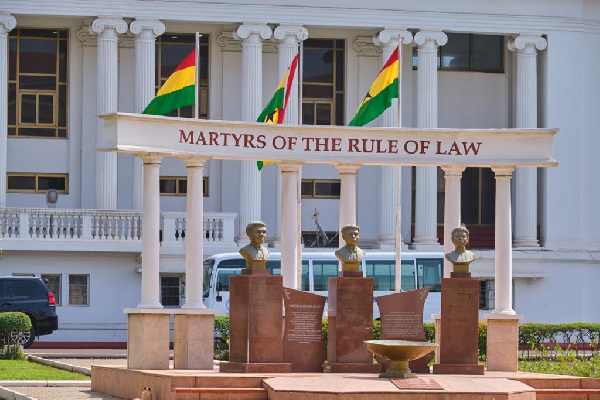Case Flash: Bedroom induced transfer of property not legally binding if…-Supreme Court saves husband
In conclusion, the Supreme court also endorsed the Court of Appeal’s directive for the sharing of the properties on a 50-50

“The respondent…explained that he was compelled to execute the said document at midnight in their bedroom from harassments of the petitioner, in order to maintain peace in their relationship and that he did not intend it to have any legal binding force…”
This was a case titled; NANA YAA KONADU vs. ALHAJI ABDUL RASHEED [2020]DLSC9912. The couple had been in an ordinance marriage for 32 years.
The woman filed a case at the High Court (as petitioner) against her husband (the respondent), for the dissolution of their ordinance marriage.
The second and last relief the petitioner asked for, apart from the dissolution, was an order for the custody or maintenance (as she put it), of the two issues in the marriage.
This second or last relief of the petitioner, which respondent also prayed for in respect of the younger child in his cross-petition, became redundant in the course of the trial when all the two issues in the marriage attained adulthood.
Petitioner however did not seek any relief on property settlement, as her case was that she never acquired any property jointly with the respondent during the subsistence of the marriage, which needed to be shared. The only thing she said she had in common with the respondent was a limited liability company called NAYAK COMPANY LTD which, according to her, the two of them established as the only shareholders and directors with fifty percent (50%) shares each.
The respondent did not challenge the petitioner’s call for the dissolution of the marriage aside from the reasons behind the call. He, however, denied the petitioner’s assertion that they never jointly acquired any properties during the subsistence of the marriage. He contended that apart from NAYAK CO. LTD and another company called RASHIDA LTD, which the two of them formed, they jointly acquired several other properties; some in his name, some in petitioner’s name, and others in their joint names. He mentioned fourteen (14) different properties, which he claimed the two acquired jointly in the course of their thirty-two (32) years of marriage, mainly through the operations of their two companies.
However, as things turned out to be, the petition assumed a complex form with the petitioner tendering EXHIBIT E, a handwritten document by the respondent which ceded most of his property to the petitioner.
Exhibit E, a unilateral, handwritten document prepared by the respondent was reproduced below:
PROPERTY DECLARATION BY ALHAJI ABDUL RASHID
“I, Alhaji Abdul Rashid, wish to declare as follows:
1. That I have ceded all ownership interest of building number 233 Airport West, another building at Airport West. One three-storey building at Adabraka official town, the building in Kumasi, the buildings in Sekondi, all the land at Elmina and New Ashongman in Accra to Nana Yaa Konadu.
2. Nayak Plaza, One building at Achimota. The Cold Store at Tema and the One storey building at New Town will be jointly owned.
3. All the businesses have (sic) been ceded to Nana Yaa Konadu with the exception of the Fabric business which will be jointly owned.
4. CARS – All the cars with the exception of the NISSAN Patrol and two Nissan Pick-ups has (sic) also been ceded to Nana Yaa Konadu.
KEEP THEM IN PEACE.
ALHAJI ABDU RASH
(Signed)”
The trial High court, in the evaluation of the evidence before it, came to the conclusion that Exhibit ‘E’ was binding on the respondent, therefore the properties and businesses mentioned therein as having been ceded to the petitioner belonged exclusively to the petitioner. According to the trial court, Exhibit ‘E’ was an agreement between the respondent and the petitioner and since the respondent did not deny its voluntary authorship, he was bound by it.
The respondent, Alhaji Abdul Rasheed was not pleased with the decision of the trial High court so he appealed against same to the Court of Appeal on seven grounds. Six grounds of appeal all centred on the legality or otherwise of Exhibit ‘E’ and its binding nature in the transfer of landed properties. In fact, the bone of contention in the appeal was purely a question of law as there were no serious factual differences between the parties with regard to the acquisition of the properties. This was; whether or not Exhibit ‘E’, without more, could validly convey the properties named therein to the petitioner as held by the trial court.
The Court of Appeal considered the submissions of both parties in the light of case law and statute; i.e. the Conveyancing Act, 1973 [NRCD 175] and the then Companies Act, 1963 [Act 179], (now amended and consolidated by the Companies Act, 2019 [Act 992]) and came to the conclusion that Exhibit ‘E’ per se, failed to qualify as a document or deed that could transfer the properties listed therein to the petitioner.
The Court of Appeal therefore reversed the decision of the trial High court to the effect that the properties mentioned in Exhibit ‘E’ exclusively belonged to the petitioner. According to the Court of Appeal, apart from the Kumasi, Adum house numbered OTB 108 &109, all the properties mentioned in Exhibit ‘E’ belonged to the parties jointly and should be shared equally on the ‘equality is equity’ principle.
Nana Yaa Konadu, also displeased with the ruling of the Court of Appeal, went to the Supreme Court seeking the judgment of the Court of Appeal to be impeached. The main contention of the petitioner/appellant in her appeal was that the Court of Appeal erred in holding that Exhibit E’ was not a valid legal document that could effectively transfer the properties mentioned therein to the petitioner.
She again contended in her last ground of appeal that the Court of Appeal erred in distributing equally in a 50–50 proportion, the matrimonial home at Airport Residential Area when, as a matrimonial home, it should have been ceded to or settled on the female spouse.
The respondent also cross-appealed against the Court of Appeal’s decision, which declared petitioner the exclusive owner of the Kumasi, Adum House, i.e. OTB 108 & 109. According to the respondent, the Kumasi, Adum house was acquired by NAYAK COMPANY LTD but not by either the petitioner or Nayak Fisheries Limited as found by the Court of Appeal
The bone of contention in the whole trial at the Supreme Court was for the panel presided by Dotse, JSC, and consisted of Appau, JSC, Pwamang, JSC, Dordzie(Mrs.), JSC, Prof. Kotey, JSC to give an interpretation to Exhibit ‘E’.
In an opinion by Appau JSC, the apex court ruled that though Exhibit ‘E’ is a declaration purporting to transfer to the petitioner ownership in some properties, mostly landed properties not properly identified, it was signed by only the declarant without any witness or attestation whatsoever, contrary to section 40 of Conveyancing Act, 1973 (Act 175).
It was therefore neither a deed nor a document capable of transferring interest in land to another. At best, it was only a declaration of intent that, in the eye of the law, did not create any legal relations between the respondent and the petitioner.
Furthermore, the Supreme Court reversed the Court of Appeal’s decision that the Kumasi, Adum house belonged exclusively to the petitioner as the same was perverse. In the court’s view, it is one of the properties acquired in the name of their jointly owned company NAYAK LTD and belongs to them equally.
Also, the court was in agreement with the Court of Appeal’s decision that all the properties acquired jointly by the parties during the subsistence of their marriage, which properties are either in the individual names or the joint names of the parties, including those mentioned in Exhibit ‘E’, as having been ceded to the petitioner, belong to the parties equally and must be distributed on the equality principle, referring Mensah vrs Mensah.
“ Dotse, JSC in MENSAH v MENSAH [2012] 1 SCGLR 391 @ 394 in the following words: – “The time has come for this Court to institutionalize the principle of ‘Jurisprudence of Equality in the sharing of marital property by spouses, after divorce, of all properties acquired during the subsistence of a marriage in appropriate cases. This is based on the provisions in articles 22 (3) and 33 (5) of the 1992 Constitution, the principle of ‘Jurisprudence of Equality’ and the need to follow, apply and improve our previous decisions in Mensah v Mensah and Boafo v Boafo. The wife should be treated as an equal partner even after divorce in the devolution of the properties…” (page 14-15).
In conclusion, the Supreme court also endorsed the Court of Appeal’s directive for the sharing of the properties on a 50-50 basis and ordered that it must be left to the parties and their lawyers to decide and that the registrar of the trial High court must not be involved in it.


